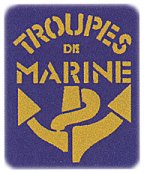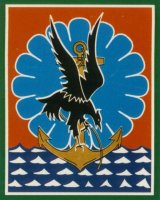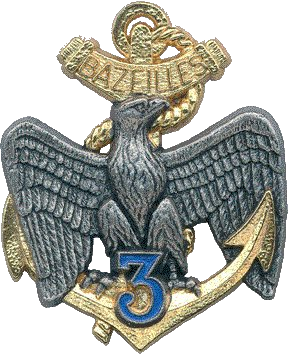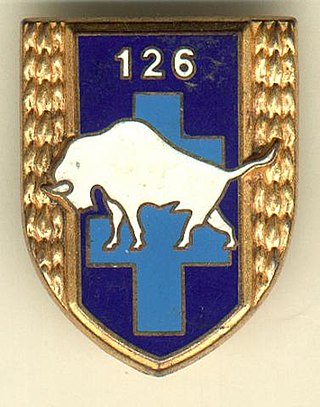
Kapisa is the smallest of Afghanistan's thirty-four provinces and is located in the north-east of the country. It has an estimated population of 523,201 people and an area of 1,842 km2 (711 sq mi), making it the most densely populated province apart from Kabul Province. It borders Panjshir Province to the north, Laghman Province to the east, Kabul Province to the south and Parwan Province to the west. Mahmud-i-Raqi is the provincial capital, while the most populous city and district of Kapisa is Nijrab.

The Troupes de Marine or TDM, sometimes simply referred to as "French Marines" in English, are one of the major components of the French Army and comprise several specialties: infantry, airborne, armoured cavalry, artillery, engineering, and transmissions (signals). Characterized by their fundamental vocation for service beyond the seas, including in French overseas territories and, formerly, in French colonies, the Marines have taken part in all French military campaigns since the corps' foundation, both on home soil and in theaters of operations around the world. They are stationed in Metropolitan France, in many French overseas departments and territories, as well as in Africa.

The 1st Marine Infantry Parachute Regiment or 1er RPIMa is a unit of the French Army Special Forces Command, therefore part of the Special Operations Command.
The structure of the French Army is fixed by Chapter 2 of Title II of Book II of the Third Part of the Code of Defense, notably resulting in the codification of Decree 2000-559 of 21 June 2000.

The 3rd Marine Infantry Parachute Regiment is one of the airborne force regiments of the Troupes de Marine. It is heir to the 3rd Colonial Commando Parachute Battalion created in 1948 and the 3rd Colonial Parachute Regiment. The regiment is part of the 11th Parachute Brigade.

The 11th Parachute Brigade is one of the French Army's airborne forces brigade, predominantly light infantry, part of the French paratrooper units and specialized in air assault, airborne operations, combined arms, and commando style raids. The brigade's primary vocation is to project in emergency in order to contribute a first response to a situational crisis. An elite unit of the French Army, the brigade is commanded by a général de brigade with headquarters in Balma near Toulouse. The brigade's soldiers and airborne Marines wear the red beret (amaranth) except for the Legionnaires of the 2ème REP who wear the green beret.

The 8th Marine Infantry Parachute Regiment is an airborne regiment of the Troupes de Marine. The 8e RPIMa was created on 28 February 1951 and the men wear the red beret. It is part of the 11th Parachute Brigade.

Opération Licorne was a French Armed Forces peacekeeping operation in support of the United Nations Operation in Côte d'Ivoire. The French forces had been stationed in the country since shortly after the outbreak of the Ivorian Civil War. The troops' main mission was to support the United Nations peacekeeping mission and to ensure the security of French and foreign nationals.

The 3rd Armoured Division is a unit of the French Army. The Division is the heir of the 3rd Algerian Infantry Division formed in 1943 and dissolved in 1946, which contributed in the liberation of Marseille during the Second World War.

The 2nd Marine Infantry Regiment is an infantry regiment of the Troupes de marine in the French Army, the only regiment to bear 16 battle honours inscriptions of the regimental colors. The regiment is one of the "quatre vieux" regiments of the Troupes de marine, with the 1st Marine Infantry Regiment 1er RIMa, the 3rd Marine Infantry Regiment 3e RIMa and the 4th Marine Infantry Regiment 4e RIMa ; also, alongside the 1st Marine Artillery Regiment 1er RAMa as well as the 2nd Marine Artillery Regiment 2e RAMa which formed the Blue Division.

The 3rd Marine Infantry Regiment is a unit of the French Army. The 3e RIMa is one of the oldest of the troupes de marine. This regiment is one of the "Quatre Grands" of marine infantry once garrisoned within the four military ports, ready to embark : the « Grand Un », the « Grand Deux », the « Grand Trois » and the « Grand Quatre ». The regiment fought in the expeditions of the 19th century in Africa, the Americas, Oceania and the Orient. Surnamed also the "3rd Marine", the unit was part of the « Blue Division » which fought at the Battle of Bazeilles on August 31 and September 1, 1870. The regiment is part of the 9th Light Armoured Marine Brigade.

The Battle of Alasay, codenamed Operation Dinner Out, was a military operation carried out by French troops of the Chasseurs Alpins's 27e Battalion and the Afghan National Army (ANA) 1st Kandak (battalion) between 14 and 23 March 2009. Marine Embedded Training Team 6-4, US Army Embedded Training Team 4-3-201, as well as other US units provided air support, both with attack helicopters and A-10 and F-15E strike aircraft. The operation enabled the construction of two bases for the Afghan Army in the Alasay valley, which had been guerrilla control since 2006.

Nicolas Le Nen is a French Army officer. Since 2007, he has commanded the 27ème bataillon de chasseurs alpins, and heads the Groupement tactique interarmes de Kapisa.

The Brigade La Fayette, also named Task Force La Fayette, was a joint unit of the French forces in Afghanistan. It was officially created on 1 November 2009, along with a complete reorganisation of the French military deployment in Afghanistan. It comprised most of the French Army units involved in the ISAF.
The Groupement tactique interarmes de Surobi, also called Task Force Dragon, is a battalion-sized unit of the French Army, based in Surobi District, in Afghanistan. It operates in the framework of the French forces in Afghanistan.

French forces in Afghanistan were involved in the War in Afghanistan from late 2001, until fully withdrawing by 2014. They operated within two distinct frameworks:
Operation Septentrion was a 36-hour military operation of the International Security Assistance Force (ISAF), a NATO-led security mission, that took place December 16–18, 2009, in the Uzbin Valley of eastern Afghanistan.

The 31st Brigade was a French Army unit created in 1981 whose components were all reassigned in 1984.

The 126th Infantry Regiment is a regiment of the French Army. It was first constituted during the French Revolution.
















